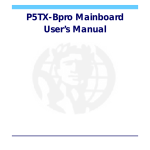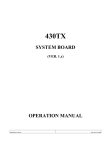Download P5TX-Apro User`s Manual
Transcript
P5TX-Apro Mainboard User’s Manual Version 2.0 Copyright © May 1997 All rights reserved Portions copyright Electronic Publishing Services from Delta Projects Ltd. This publication may not be copied, reproduced, translated, transmitted or reduced to any printed or electronic medium or to any machine readable form, or stored in a retrieval system, either in whole or in part without the written consent of the copyright holders. The contents of this publication are subject to change. The manufacturer reserves the right to alter the contents of this publication at any time and without notice. The contents of this publication may contain inaccuracies or typographical errors and is supplied for informational use only. Products are noted in this publication for identification purposes only. Microsoft is a registered trademark and Windows is a trademark of Microsoft Corporation. Pentium is a trademark of Intel Corporation. All other product names or brands may be trademarks or registered trademarks of their respective holders. P5TX–Apro User’s Manual Table Of Contents – III 1: P5TX-Apro Package & Product Information ......................................1 - 1 About This Manual............................................................................................... 1 - 1 Acrobat Document Features ....................................................................................... 1 - 1 Manual Features......................................................................................................... 1 - 2 Package Contents .............................................................................................. 1 - 3 Component Information ..................................................................................... 1 - 6 Expansion Cards & Slots ............................................................................................ 1 - 6 Memory Sockets & Modules .......................................................................................1 - 7 CPU Socket & CPU .......................................................................................................1 - 7 Port & Controller Connections .....................................................................................1 - 7 2: Using Your Mainboard ..................................................................... 2 - 1 System Controls .................................................................................................. 2 - 1 Hardware Controls & Indicators ................................................................................ 2 - 1 CMOS Setup Utility Controls ....................................................................................... 2 - 3 Hardware Features............................................................................................ 2 - 6 Onboard Ports ............................................................................................................ 2 - 6 Connectors .................................................................................................................. 2 - 6 Optional Hardware Connectors................................................................................. 2 - 9 Firmware & Software ....................................................................................... 2 - 10 How To Use The CMOS Setup Utility ........................................................................ 2 - 10 Clearing CMOS ......................................................................................................... 2 - 10 Flashing The BIOS ..................................................................................................... 2 - 12 Bus Master Drivers ................................................................................................... 2 - 12 P5TX–Apro User’s Manual Table Of Contents – IV 3: Reconfiguring Your Mainboard ........................................................ 3 - 1 Installing Expansion Cards .................................................................................. 3 - 1 ISA Cards & Slots ........................................................................................................ 3 - 1 Configuring Expansion Card Resources In CMOS Setup .......................................... 3 - 2 Adding System Memory .................................................................................... 3 - 6 Memory Configurations ............................................................................................. 3 - 6 Installing A CPU Upgrade .................................................................................. 3 - 9 The Basic Procedure ................................................................................................... 3 - 9 Configuring External Clock Speed & Factor ............................................................. 3 - 10 Configuring CPU Voltage.......................................................................................... 3 - 10 CPU Jumper Tables & Illustrations ........................................................................... 3 - 12 Adding An IDE Peripheral ................................................................................. 3 - 16 IDE Transfer Modes ................................................................................................... 3 - 16 Installing IDE Devices ................................................................................................ 3 - 18 4: P5TX–Apro Reference Information .................................................. 4 - 1 Using This Section ............................................................................................... 4 - 1 Jumper Configuration Summary........................................................................ 4 - 3 Supported CPUs ................................................................................................ 4 - 8 Interpreting CPU Markings ......................................................................................... 4 - 9 System Memory Specifications ..........................................................................4 - 11 Memory Configurations ............................................................................................ 4 - 11 CMOS Setup Utility Summary ........................................................................... 4 - 12 Using the CMOS Setup Utility ................................................................................... 4 - 12 Accessing The CMOS Setup Utility ........................................................................... 4 - 12 Standard CMOS Setup .............................................................................................. 4 - 16 BIOS Features Setup ................................................................................................ 4 - 20 Chipset Features Setup............................................................................................ 4 - 25 Power Management Setup ...................................................................................... 4 - 27 PNP/PCI Configuration ............................................................................................ 4 - 34 PC Health Monitor ................................................................................................... 4 - 42 P5TX-Apro User’s Manual 1: Package & Product Information – 1.1 P5TX-Apro Package & Product Information This manual contains all the information you’ll need to use the P5TX-Apro mainboard. Please take a moment to familiarize yourself with the design and organization of the manual. About This Manual In This Section: About This Manual Package Contents Component Information This manual is designed mainly as an online document. In addition to reading it on your display screen your can also print it out. In some circumstances, you may have received this manual as a printed document, in which case you can skip the following section about the online version. Acrobat Document Features This manual is in Adobe Acrobat format. It requires Adobe Acrobat Reader version 3.0 or later to view it. Acrobat Reader for Microsoft Windows95 is supplied on the Support CD-ROM disk that contains this manual. It is installed on the Support CD and there is also an installation file that will automatically run the Acrobat Reader installer program to install it on your system hard disk. If you were not aware of this, you are probably viewing this document from the Support CD installation and Reader loaded automatically when you opened this manual. If this is the case, you may want to install Acrobat Reader on your system hard disk. You can copy the Manual directory over as well so that the manual is readily available without having to hunt up the Support CD when you want to view it. If you are unfamiliar with Acrobat Reader, please take a moment to view the Reader Online Guide which is available under the Help menu when you run Reader. The README file in the Manual directory on the Support CD explains what to do if you need to view this document under an OS other than Windows95. P5TX-Apro User’s Manual 1: Package & Product Information – 1.2 Manual Features The online version of this manual provides some additional navigation features not available in a conventional print document. You can click on entries in the Table of Contents and jump to that location in the manual. In addition, there are buttons at various points in the manual that are shortcuts to the topic displayed on the button. This manual also uses some icons to call your attention to important information. The icons appear in the sidebar and represent the following: G C D N • Important information • A recommendation or good idea • A warning or bad idea • Danger warning If You Have The Printed Manual Obviously it is not possible to provide the additional navigation features in print form. In order that you can still find things with relative ease, where appropriate we have noted the locations of additional information referred to. P5TX-Apro User’s Manual 1: Package & Product Information – 1.3 Package Contents Documentation Versions If you received this manual stored on a CD Support Disk, you will also have received a printed “Quick Installation” Guide. If you have the printed version, the Support Disk may not be a CD. If so, the manual and Acrobat folders will not be on the disk. The P5TX–Apro mainboard package contains the following items, as noted in the Quick Installation Guide (which comes with the CD Documentation version of the mainboard.). We’ve listed them here again for your convenience. Please inspect the package contents and confirm that everything is there. If anything is missing or damaged, call your vendor for instructions before proceeding. The package includes: • P5TX–Apro Mainboard • Cable Pack: – 1 Floppy Controller Cable – 1 IDE Controller Cable • Support Disk: – Driver Files Folder – Manual Folder – Adobe Acrobat Folder The mainboard comes with IDE Bus Master drivers for several Operating Systems. The drivers are organized in individual folders by OS. In each folder there is a “readme” file that explains how to install the driver. Please locate the folder for the driver you need and check this file. P5TX-Apro User’s Manual 1: Package & Product Information – 1.4 P5TX-Apro You can use the photograph and the illustration on the next page to familiarize yourself with the components on the P5TX–Apro mainboard. The Enhanced IDE and Floppy Disk Drive connectors have a notch in one side to orient the cables correctly. The mainboard comes with one IDE cable. If you install devices on the second IDE channel with another cable, it may not have the orientation extrusion on the side of the cable connector, which prevents attaching the cable incorrectly. Please check the section on Installing IDE Devices for more information. P5TX-Apro User’s Manual 1: Package & Product Information – 1.5 COM1 KB/Mouse COM2 Intrusion USB Port Parallel DIMM1 DIMM2 DIMM3 ISA Slots 3 2 1 Socket 7 PCI Slots 4 3 2 1 CPU Socket 7 Wake Up Power Battery IDE 2 IR Port Fan Power P5TX-Apro Layout The illustration above shows the connectors, sockets and ports and the mainboard. IDE 1 Fan Power Floppy Case Features The COM1 and COM2 ports are underneath the Parallel port. The USB ports and the PS/2 Keyboard and Mouse ports are stacked one above the other. The Intrusion and Wake-up connectors are for signal cables that are monitored by the onboard sensor. The ATX power connector is on the right in this view. P5TX-Apro User’s Manual 1: Package & Product Information – 1.6 Component Information This section is a brief description of the components on the mainboard that you might need to know about if you want to upgrade or change your system configuration. If your mainboard is already installed in a system, it isn’t necessary for you to review this section. This mainboard uses the ATX ‘form factor’, a design that integrates many features onto the board including some number of external ports. Expansion Cards & Slots The mainboard has seven expansion slots for system expansion or ‘add-on’ cards. Three of them are ISA slots, the other four are PCI slots. When you get an expansion card, it must use one of these to connect to the computer. The ISA expansion slots are a legacy of the original IBM PC/ AT design. They are 16-bit slots that run at a moderate bus speed. There are many kinds of expansion cards that use this slot design to connect to the computer, some of the most common being sound and modem cards. PCI slots are the current high-speed 32-bit standard for system expansion cards. They operate at a faster speed and have a greater data throughput than ISA cards. Expansion cards often make use of system resources, which requires managing the system resource configuration. Most newer expansion cards support the ‘Plug and Play’ standard that allows an Operating System like Windows95 to automatically detect them and configure system resources as needed. Some older ISA designs may not support this standard and may therefore require manual configuration. You should consult the specifications or documentation for a card to determine if this is the case and what needs do be done to properly configure the card. P5TX-Apro User’s Manual 1: Package & Product Information – 1.7 Memory Sockets & Modules There are three memory module sockets on the mainboard. They use 168-pin DIMM memory modules. The sockets function independently of each other. This mainboard has a very flexible memory design that allows the use of a variety of memory options up to a total of 256MB. There is more information about this in Adding System Memory section of Section 3: Reconfiguring Your Mainboard. CPU Socket & CPU The Socket 7 CPU socket supports the full range of Pentium®class CPUs including MMX Pentiums®. Installing a CPU in the socket is easy. The lever at the side of the socket latches the CPU in place when it is down and releases it when raised. If you want to install a CPU upgrade or are installing a CPU on the board for the first time, please refer to ‘Installing a CPU’ in Section 3: Reconfiguring Your Mainboard. Port & Controller Connections This mainboard has two external Serial ports, a Parallel port, two USB (Universal Serial Bus) ports and both a PS/2-type keyboard and mouse port built onto the board. There are also several connectors built onto the board. There are connectors for four IDE devices in two ‘channels’ and for two floppy disk drives. There are also connectors on the board for some system case features, CPU and other cooling fans and some other hardware features. Details about these connectors are in Section 4: Reference Information. P5TX-Apro User’s Manual 1: Package & Product Information – 1.8 P5TX–Apro User’s Manual 2: Using Your Mainboard – 2.1 Using Your Mainboard In This Section: This section covers the following topics: • System Controls & Indicators • Hardware Features • Firmware & Software They go over the system control features and status indicators that derive from the mainboard and explain the software that comes with or is built-into the mainboard System Controls System Controls Hardware Features There are two topics in this section, a explanation of the hardware controls and status indicators that connect from the mainboard to your system case and some information about the parts of the CMOS Setup Utility that allow you customize some system features. Firmware & Software Hardware Controls & Indicators There are some control features and status indicators that connect from the mainboard to your system case, which is sometimes called the ‘Enclosure’ or ‘Chassis.’ These are: • Power Switch • Power Status Indicator • Suspend Switch • Suspend Status Indicator • Reset Switch • Hard Disk Drive Activity Indicator • Keyboard Lock All of these case features connect to the mainboard via connector strip J10. Not all system cases have all of these features, so your system may not have all of them. The functions and options for these are shown in the table on the next page. P5TX–Apro User’s Manual 2: Using Your Mainboard – 2.2 Hardware Control & Indicator Connectors Feature J10 Pins Function Power Status LED 1-3 When lighted indicates that system is turned on Pin 1: + ; Pin 2: + ; Pin 3: – Suspend Switch 4-5 Puts the system into Suspend state under Operating Systems that support this power management feature Suspend LED 6-8 When lighted indicates the system is suspended Pin 1: + ; Pin 2: + ; Pin 3: – Reset Switch 9-10 Pressing the Reset switch restarts the system Keyboard Lock 11-12 Disables keyboard via a lock mounted on front panel of the case Speaker 13-16 Connects to the PC speaker mounted on the system case Pin 1: + HDD Activity LED 17-18 Flashes when hard disk drive is active Pin 1: + ; Pin 2: – Power Switch 19-20 Turns the system power on and off. Default sets this to dual function as power and suspend switch. Press once for Suspend, hold for >4 seconds for Off. To set as Power only, change setting in the Power Management section of the CMOS Setup utility. P5TX–Apro User’s Manual 2: Using Your Mainboard – 2.3 CMOS Setup Utility Controls Two sections of the CMOS Setup Utility allow you to configure how some of your system’s features work. These are: • BIOS Features Setup • Power Management Setup The CMOS Setup Utility is a program that is permanently stored in the BIOS chip on the mainboard. The utility creates a system hardware configuration record that it stores in a small amount of battery-supported memory on the board. The BIOS uses this record to function as an interface between the system hardware and the operating system. Most of the settings in the CMOS Setup Utility are made automatically, so you won’t normally need to use this program. You can, however, customize some of the operational features to suit how you prefer to use the system. The screen illustrations on the next two pages show the Setup Default settings for these two sections of the utility. The CMOS Setup Utility Summary in Section 4: Reference Information, lists the setting options for each section of the utility including the two noted above. P5TX–Apro User’s Manual 2: Using Your Mainboard – 2.4 CMOS Setup Utility – BIOS Features Setup This section of the setup utility allows you to configure some system features including Virus Warning, Boot Sequence and Security Option. Virus Warning – When enabled, monitors the primary hard disk boot sector and warns of any attempt to write to it. Boot Sequence – Controls the order in which the system checks disk drives for a boot disk. Security Option – Sets the level of password protection for the system. P5TX–Apro User’s Manual 2: Using Your Mainboard – 2.5 CMOS Setup Utility – Power Management Setup This section of the setup utility allows you to configure the power management features supported by the BIOS. These can also operate in tandem with Operating System power management features. You can use the Min Saving or Max Saving default modes or you can configure the power management features individually in the User Define mode. P5TX–Apro User’s Manual 2: Using Your Mainboard – 2.6 Hardware Features This section is a brief overview of information about the mainboard’s hardware features that connect to external devices. Onboard Ports There are five external ports on the mainboard. These are ports standard to most personal computers: • COM1 Serial Port A high-speed serial port which can also be configured as the COM3 port in the CMOS Setup Utility. • COM2 Serial Port A high-speed serial port which can also be configured as the COM4 port in the CMOS Setup Utility. • Parallel Port The parallel port can be configured as a Standard, ECP or EPP parallel port in the CMOS Setup Utility • PS/2 Keyboard Port & PS/2 Mouse Port (stacked) • USB ports – two ports (stacked) Connectors There are several connectors on the mainboard for connecting additional ports and internal peripheral devices • IDE 1 – Primary IDE Channel A high-speed serial port which can also be configured as the COM3 port in the CMOS Setup Utility. • IDE 2 – Secondary IDE Channel A high-speed serial port which can also be configured as the COM4 port in the CMOS Setup Utility. • Floppy Connector The parallel port can be configured as a Standard, ECP or EPP parallel port in the CMOS Setup Utility P5TX–Apro User’s Manual 2: Using Your Mainboard – 2.7 CMOS Setup Utility – Integrated Peripherals This section of the setup utility configures the IDE and Floppy controllers and the settings for the external ports This section enables and configures the optional USB and Infrared features. The screen illustration shows the settings when Setup Defaults are loaded. P5TX–Apro User’s Manual 2: Using Your Mainboard – 2.8 Case Security The mainboard has a case security feature that will warn if the system case or ‘chassis’ has been opened since the last time the system was used. There is a photoelectric cell mounted on the mainboard that is active when the system is turned off and will detect the case being opened. The next time you turn the system on a warning message will appear on screen during the POST (Power On Self Test) before the Operating System loads. The J18 connector on the mainboard connects to a chassis intrusion signal cable. Cooling Fan Connectors There are three cooling fan connectors on the mainboard that support cooling fans with power management features. If you connect this type of fan, and the ‘CPU FAN Off In Suspend’ line in the CMOS Setup utility’s Power Management Setup section is set to Enabled, the system will turn the fans off when the system is in Suspend mode. Modem Wake-Up The J19 connector on the mainboard is for connecting a signal cable from a modem that supports a modem ring system wake up feature. With such a modem installed and connected to the mainboard via this connector, the system will wake up from Suspend mode when an incoming call is received by the modem. The ‘Ring-In Event’ line in the CMOS Setup utility’s Power Management Setup section must be set to Enabled for this feature to function. Power Supply Selection There are two power supply connectors on the mainboard. One is for a standard PS/2–type power supply and the other for an ATX power supply. You must indicate which type is connected to the mainboard for power management purposes. You do this by setting the ‘Power Supply Type’ line in the CMOS Setup utility’s Power Management Setup section to the correct type. P5TX–Apro User’s Manual 2: Using Your Mainboard – 2.9 The default setting is ATX, so you will not need to change this if you are using an ATX power supply. With an ATX power supply, the system will turn the power off automatically when exiting Windows95. “PC Health” Monitoring In order to detect potentially damaging conditions while the mainboard is operating, the mainboard has an onboard sensor that monitors temperature and voltage levels. In the event that these exceed predefined limits, the system will automatically react in attempt to prevent damage. The PC Health Monitor section of the CMOS Setup utility sets the controls for this feature and also displays data from the onboard sensor. UltraDMA Hard Disk Drive Support This mainboard supports hard disks that use UltraDMA data transfer. You attach an UltraDMA drive to one of the IDE cables. If you use the Optimum Settings feature in the CMOS Setup utility the system will automatically detect the drive and configure the system to use it. Optional Hardware Connectors There are additional feature connectors on the mainboard for optional ports. These require optional external port hardware. IR Ports There is one standard and one optional connector on the mainboard which support an IR (infrared) port module that enables wireless communication between the computer and other computers and devices with an infrared port. The default IR connector, J13, is for SIR and the optional J12 connector is for Fast IR.. The port module is an optional component. If it is installed, you must set the UART 2 line in the Integrated Peripherals section of the CMOS Setup utility to the appropriate IR mode used by the module. P5TX–Apro User’s Manual 2: Using Your Mainboard – 2.10 Firmware & Software The mainboard hardware is supported by both firmware and software components. Firmware is software that is stored on a chip on the board rather than on disk media. The firmware component you interface with on this mainboard is the CMOS Setup Utility. This utility establishes various settings used by the BIOS, the basic software that is an interface between the system hardware and software. The software component is comprised of software drivers that support the PCI IDE controller and some of the other hardware features. How To Use The CMOS Setup Utility The CMOS Setup Utility options are listed in detail in Section 4: Reference Information. This section is just a brief explanation of how to run the program to adjust settings as noted in this and the next section. To run the CMOS Setup Utility, press the Del or Delete key while the computer is starting up, before the operating starts to load. The utility’s main screen will appear as shown on the next page. To navigate the program, use the controls shown on the screen. The utility has several sections. Many of the features configured by the utility are set to operate automatically when the ‘Setup Defaults’, the recommended mode, are used. With Setup Defaults loaded you can still customize various settings. Clearing CMOS Under some unusual circumstances the configuration record created by the CMOS Setup utility and stored on the mainboard can become corrupted and unusable, possibly leading to the board being unable to operate properly. If this happens, the CMOS record can be cleared by setting jumper JP2 to the clear setting for a moment and then setting it back to the Normal setting. Refer to Section 4 for more information. P5TX–Apro User’s Manual 2: Using Your Mainboard – 2.11 CMOS Setup Utility – This is the main screen for the setup utility from which you access its various sections. The function and use of each section is covered in Section 4: Reference Information. P5TX–Apro User’s Manual 2: Using Your Mainboard – 2.12 Flashing The BIOS This mainboard uses the Award BIOS. The BIOS is stored on a programmable flash memory chip on the mainboard. Updates to the BIOS can be installed by installing a new BIOS file on the flash chip, which replaces the existing one. You do this using software that comes on the Support Disk. There is an explanation of how to install a BIOS update in a ‘readme’ text file included with the program. Bus Master Drivers This mainboard comes with software drivers, for various Operating Systems, that enable the PCI controller to operate in ‘Bus Master’ mode. The drivers are on the Support Disk. The included ‘readme’ file has information on the drivers and installation information. P5TX–Apro User’s Manual 3: Reconfiguring Your Mainboard – 3.1 Reconfiguring Your Mainboard This section explains how to install new hardware on your mainboard. It covers installing expansion cards, adding system memory, changing the CPU and installing additional IDE peripheral devices such as a hard disk or a CD-ROM drive. Installing Expansion Cards In This Section: Installing Expansion Cards Adding System Memory Installing A CPU Upgrade Adding An IDE Peripheral There are seven expansion card slots on the mainboard, three ISA slots and four PCI slots. When you get an expansion card, it will come with instructions on how to install it, so this section covers relevant information from the mainboard side only. ISA Cards & Slots ISA expansion cards often use system resources in the form of IRQs and DMA channels. Newer cards that comply with the Plug and Play (PnP) standard are designed to allow the Operating System to automatically configure system resources. Cards that do not support PnP may require manual configuration of both the card hardware and settings in the CMOS Setup Utility. If you have a PnP-compliant card to install there should be little to do other than follow the installation instructions. If, however, you have a non-PnP card and it requires configuring system resources, you may need to review the third part of this section, Configuring Expansion Card Resources In CMOS Setup. P5TX–Apro User’s Manual 3: Reconfiguring Your Mainboard – 3.2 PCI Cards & Slots With very few exceptions, any PCI expansion card you are likely to get will be Plug an Play compliant. If you are using an Operating System that supports PnP, such as Windows 95, you should be able to follow the installation instructions that come with the card and have the Operating System automatically recognize and configure the card. The four PCI slots on the mainboard all have ‘Bus Master’ capability. For installed PCI cards to use this feature an Operating System-specific Bus Master software driver that comes with this mainboard must be installed under your Operating System. These drivers are located on the Support Disk. There is more information about them later in this section. Running CMOS Setup Configuring Expansion Card Resources In CMOS Setup To run the CMOS Setup utility, press the Delete or the Del key while your computer is first starting up. Select the ‘PNP/PCI CONFIGURATION’ item on the main screen and press the Enter key to open it. When you are finished, press the Esc key once to return to the main screen and then select ‘SAVE & EXIT SETUP’ and press the Enter key to save the new configuration. For more information on this see Section 4: Reference Information. The CMOS Setup Utility, which is covered in detail in Section 4: Reference Information, has a section called PNP/PCI Configuration. The default settings in this section allow the Operating System to automatically configure IRQ resources for PnP compliant ISA and PCI Cards. If you need to install a non-PnP card, you will need to configure any IRQ and DMA settings manually, both on the card and in the CMOS Setup Utility. The following three pages show how to do this. P5TX–Apro User’s Manual 3: Reconfiguring Your Mainboard – 3.3 CMOS Setup Utility – PnP/PCI Configuration This is the default screen for this section when Setup Defaults are loaded. If you need to manually configure the IRQ settings, set the first item on the screen to the ‘Manual’ setting. See the next page. If you install an Operating System that supports Plug and Play, such as Windows95, you should set the first line, ‘PNP OS Installed’ to ‘Yes’. P5TX–Apro User’s Manual 3: Reconfiguring Your Mainboard – 3.4 CMOS Setup Utility – PnP/PCI Configuration When ‘Resources Controlled By’ is set to ‘Manual’ you can individually configure the IRQ & DMA channel settings. The individual defaults are for PnP cards and will still use all the items listed to automatically assign resources as needed. If you are installing a ‘legacy’ ISA card that requires manual configuration, you can manually assign the required resources as needed. See the next page for an example. P5TX–Apro User’s Manual 3: Reconfiguring Your Mainboard – 3.5 CMOS Setup Utility – Pnp/PCI Configuration This screen shows an example of a manually configured IRQ setting for a “Legacy’ ISA expansion card. Legacy cards, by definition, are not PnP compliant and must be manually configured if they require an IRQ or DMA channel. See the card manual for specifics. When an item in the list is configured this way, it is no longer part of the pool of automatically configurable resources. For this reason, don’t configure ISA cards this way unless they are Legacy cards. P5TX–Apro User’s Manual 3: Reconfiguring Your Mainboard – 3.6 Adding System Memory There are some requirements you must follow if you want to install system memory. The memory subsystem has three 168pin DIMM sockets which function independently. This mainboard supports both EDO DRAM and SDRAM (Synchronous DRAM) modules. You can use module sizes from 8MB to 128MB, either single or double-sided. The total supported memory capacity for this mainboard is 256MB. If your mainboard is already installed in a system, it will have some amount of memory installed on the board. You can tell how much by checking the configuration screen that appears when the computer is starting up. With some memory installed, there may be one or two sockets available to add additional memory. Memory Configurations You can install any combination of module sizes as long as you follow these requirements: • All modules must be 3.3–Volt • All modules should have the same operating speed, e.g. 60ns (nanoseconds) Other than these requirements, there is no limitation on the variety of combinations, so they are not listed here. We recommend using one type of DRAM, either EDO or Synchronous. SDRAM is faster than EDO. Note: It is possible to install more memory than the board supports. Do not install more than 256MB on this mainboard, the system will ignore additional memory. P5TX–Apro User’s Manual 3: Reconfiguring Your Mainboard – 3.7 1 2 3 Retaining Clamp DIMM Sockets The picture above shows the memory module sockets in detail. The sockets are numbered DIMM1 to DIMM3 starting from the top socket in the picture. Modules press into place and are held in position by a retaining clamp at each end of the socket. When you want to remove a module, press down on the retaining clamps to push the module out of the socket. P5TX–Apro User’s Manual 3: Reconfiguring Your Mainboard – 3.8 Installing Memory Modules To install a DIMM module, look at the module and note the position of the shorter section of the connector edge that plugs into the DIMM socket. Note the position of the shorter section of the socket. Orient the module so that these match and press the module into the socket at a 90° angle. The retaining clamps at each end of the socket will rotate upwards automatically to secure the module in place. Modules are designed so that they will only insert in one orientation. If you have trouble inserting the connector edge of the module into the socket, it may be oriented the wrong way. Turn the module around and try again. You shouldn’t need to force it. If All Sockets Are Occupied If you want to install more memory and there are no sockets available, you must remove some installed modules and replace them with the upgrade modules. If you have to do this, make sure to identify what type of memory is already installed. In some cases, there may be a mix of module types. You can tell this by checking the configuration screen that appears while the computer is starting up. Press the Pause key to temporarily interrupt the start-up process while the screen is visible so that you have more time to read it. When you’re done press any key to resume. Remove the lowest performance and smallest size modules and replace them with the upgrade. P5TX–Apro User’s Manual 3: Reconfiguring Your Mainboard – 3.9 Installing A CPU Upgrade If you are installing this mainboard it will not have a CPU installed unless your vendor installed one when you purchased the board. If the mainboard is installed in a system, there will already be a CPU installed. In either case the information and procedure for installing a CPU is the same. Since the more likely scenario is that you are installing an upgrade, this section assumes that is what you are doing. The Basic Procedure To install a CPU on this mainboard you need to set up the board for a specific CPU by doing the following: • Set the External Clock Speed • Set the Clock Multiplier Factor • Set the CPU Voltage You configure the CPU settings by adjusting jumper settings on the board. In order to do this, you will need to know some information about the CPU you plan to install. This should be provided by the CPU vendor or by the vendor you buy the chip from. You’ll need the following information: • CPU Internal Clock Speed • CPU Voltage The internal clock speed is the speed the CPU operates at to process data and is the one used by CPU manufacturers to indicate the speed of the chip, for example, a 133MHz Intel Pentium®. The CPU also has an external clock speed which is the speed at which it interacts with external components. CPU voltage may either be the same internally and externally or it may be split, depending on the CPU design. Some processors use one voltage for the ‘core’ (Vcore) and another for input/ output (Vio). P5TX–Apro User’s Manual 3: Reconfiguring Your Mainboard – 3.10 Configuring External Clock Speed & Factor To configure the board for a CPU’s internal clock speed, you have to set the external clock speed (sometimes referred to as the bus speed) and the clock factor so that the result is the internal clock speed of the CPU you are installing. For example, the default setting for these is: 66.6MHZ [external clock] x 2.0 [clock factor] =133.2MHz or, an effective setting of 133MHz. Since the internal clock speed the CPU is supposed to operate at is fixed, the two factors, external clock and clock factor, are the variables. The CPU manufacturer or vendor’s information should tell you what these factors should be. P Rated CPUs Cyrix, IBM and AMD all make Pentium®-class CPUs that are performance rated at an Intel Pentium® equivalent speed but actually have a slower internal clock speed. This ‘P’ rating is used to indicate the CPU’s performance rather than its internal clock speed. For example, the Cyrix/IBM P166 has an actual internal clock speed of 133MHz. If you install a CPU of this type, make sure you set the mainboard for the actual internal clock speed of the CPU, not its P rating. Configuring CPU Voltage The CPU voltage specification should also be provided in information from the manufacturer or vendor. Standard Pentium® CPUs are single voltage. MMX Pentiums® are dual-voltage. You should set the CPU Voltage jumpers according to the specifications you get with the CPU. P5TX–Apro User’s Manual 3: Reconfiguring Your Mainboard – 3.11 CPU Settings Intel Pentium CPUs Internal Clock 75MHz 90MHz 100MHz 120MHz 133MHz 150MHz 166MHz 200MHz 233MHz External Clock 50MHz 60MHz 66.6MHz 60MHz 66.6MHz 60MHz 66.6MHz 66.6MHz 66.6MHz Clock Factor 1.5 1.5 1.5 2.0 2.0 2.5 2.5 3.0 3.5 50MHz 55MHz 60MHz 66.6MHz 75MHz 2.0 2.0 2.0 2.0 2.0 75MHz 2.0 50MHz 60MHz 66.6MHz 60MHz 66.6MHz 60MHz 66.6MHz 1.5 1.5 1.5 1.5 1.5 2.0 2.0 66.6MHz 66.6MHz 3.0 3.5 Cyrix/IBM CPUs 6X86 P120+ (100MHz) P133+ (110MHz) P150+ (120MHz) P166+ (133MHz) P200+ (150MHz) 6X86MX 150MHz AMD CPUs K5 PR75 (75MHz) PR90 (90MHz) PR100 (100MHz) PR120 (90MHz) PR133 (100MHz) PR150 (120MHz) PR166 (133MHz) K6 PR200 (200MHz) PR233 (233MHz) P5TX–Apro User’s Manual 3: Reconfiguring Your Mainboard – 3.12 CPU Jumper Tables & Illustrations C In practice, for an Off setting on a two-pin jumper, place the cap over one pin so that it doesn’t get lost. The next few pages show the CPU jumper settings. The settings are listed in the tables as follows: • Where two pins are shorted (connected) by a jumper cap on a three-or-more-pin jumper the shorted pins are listed, e.g. 1-2 or • For a two-pin jumper, On, if the cap is in place, and Off, if the cap is not in place. In the jumper illustrations, the Pin 1 position is shaded and the jumpers, shown in a “bird’s eye” view, look like this: A jumper with a cap in position looks like this: The default settings are noted in the tables. P5TX–Apro User’s Manual 3: Reconfiguring Your Mainboard – 3.13 CPU Jumper Settings Function Jumper External Speed JP1* Settings 55MHz 11-13, 17-19, 20-22 60MHz 11-13, 17-19, 18-20 61.6MHz 11-13, 18-20, 19-21 Default 66MHz 9-11, 17-19, 18-20 68.4MHz 9-11, 18-20, 19-21 75MHz 9-11, 17-19, 20-22 * Jumper JP1 is divided into three sections, Pins 1-6, 9-14 &17-22, separated by pinless spacers Internal Clock Factor JP1* 1.5x & 3.5x 1-3, 2-4 Default 2.0x 1-3, 4-6 2.5x 3-5, 4-6 3.0x 3-5, 2-4 * Jumper JP1 is divided into three sections, Pins 1-6, 9-14 &17-22, separated by pinless spacers CPU Core Voltage JP4 On= Cap On (One cap for this jumper) 2.54V Default 2.84V 2.94V 3.24V 3.34V 1-2 On 3-4 5-6 JP2 9-10 On On Other Jumper Settings Clear CMOS 7-8 Default Normal 2-3 Clear 1-2* * Put cap on jumper for a moment and then remove to clear current settings On On P5TX–Apro User’s Manual 3: Reconfiguring Your Mainboard – 3.14 2.5x JP1 2 6 External Clock Speed 55MHz JP1 68.4MHz JP1 10 14 18 22 10 14 18 22 13 17 21 9 13 17 21 9 60MHz JP1 75MHz JP1 10 14 18 22 10 14 18 22 9 17 21 9 17 21 13 61.6MHz JP1 13 Internal Clock Factor 10 14 9 13 18 17 22 21 1.5x & 3.5x JP1 2 6 1 66MHz JP1 10 14 18 22 9 17 21 13 5 2.0x JP1 2 6 1 5 1 5 3.0x JP1 2 6 1 5 CPU Core Voltage (Vcore) 2.54V JP4 2 1 9 10 2.84V JP4 2 1 9 10 2.94V JP4 2 1 9 10 3.24V JP4 2 1 9 10 3.34V JP4 2 1 9 10 P5TX–Apro User’s Manual 3: Reconfiguring Your Mainboard – 3.15 JP2 JP4 Socket 7 JP1 Jumper Locations The illustration above shows the location of the jumpers illustrated on the previous page. P5TX–Apro User’s Manual 3: Reconfiguring Your Mainboard – 3.16 Adding An IDE Peripheral This section covers some aspects of installing internal IDE peripheral devices as they relate to the mainboard. The onboard Enhanced IDE controller supports up to four devices, two per IDE channel. The primary hard disk drive in most systems is an IDE device. You may want to install more hard disks, a CD-ROM drive or combination of these and other devices. This mainboard supports both PIO and UltraDMA modes, which it can detect automatically. You can install a mix of devices. With the Setup Defaults loaded in the CMOS Setup utility, the system will automatically detect and configure multiple devices of whatever mode. IDE Transfer Modes Hard disk read and write operations are executed via the mainboard chipset. The transfer of data between the hard disk and the system takes place using one of a number of transfer modes – either one of several PIO modes or UltaDMA mode. Although there are several PIO Modes (0 through 4), and this mainboard supports all of them, most current hard disk and CDROM drives use either Mode 3 or 4. The greater the mode number, the faster the transfer rate, so you should use the fastest mode the device can operate at. With Setup Defaults loaded in the CMOS Setup Utility, the system will automatically detect the fastest mode a device can use and set it for that mode. UltraDMA is another transfer method that provides even faster data transfer than PIO modes. To use it you must install a drive that uses this transfer method. Drives that use PIO Mode transfer can not use the UltraDMA setting. The settings for drive modes are in the Integrated Peripherals section of the CMOS Setup utility. The screen illustration at right shows the Setup Defaults settings. P5TX–Apro User’s Manual 3: Reconfiguring Your Mainboard – 3.17 CMOS Setup Utility – Integrated Peripherals The illustration above shows the Setup Defaults settings for this screen. You can install IDE devices under these settings and the system will automatically detect and set the best mode for each device. You can also set the transfer mode for each device manually, although we recommend using the default settings unless you have a reason not to and you know what you are doing. P5TX–Apro User’s Manual 3: Reconfiguring Your Mainboard – 3.18 Installing IDE Devices The mainboard’s Enhanced IDE controller supports four devices in two channels, IDE1 and IDE2. These are called the Primary and Secondary IDE channels. Each channel supports two devices, the first device is called the Master device and the second the Slave device. You must configure any IDE device you install to operate as one or the other. To find out how to configure the device you plan to install you should refer to the manual that comes with the device. You may need to set jumpers or switches to configure it. IDE Cables The mainboard comes with one IDE ribbon cable to connect two devices to the mainboard. If you need to install devices on the second channel you will need to get another IDE cable. These are a standard and inexpensive item that you can generally find at any computer supply store. One edge of the cable is colored to indicate the Pin 1 side. When you connect the cable to the mainboard and a device you must orient the cable so that this colored edge is at the Pin 1 side of the connector you are attaching it to. The mainboard IDE connectors have an orientation cut-out to ensure correct orientation, and the supplied cable has an orientation tab on the side of the connector. Some IDE cables do not have this tab and therefore are not forced to use the correct orientation. You should check that any cable you buy has orientation tabs on the side of the connectors. If you get a cable that does not have them, make sure the cable is correctly oriented when you attach it to the board and the device. P5TX–Apro User’s Manual 3: Reconfiguring Your Mainboard – 3.19 IDE cables have three connectors on them, one at each end and one in-between, closer to one of the ends. When you install a device on the second channel, attach the lone end to the IDE2 connector on the mainboard. The two connectors that are closer to each other are for connecting to IDE devices. The connector on the end is for the Master device and the connector in the middle is for the Slave device. IDE Devices & CMOS Setup When you install a new hard disk drive its parameters will be automatically detected by the BIOS and entered in the Standard CMOS Setup section of the CMOS Setup utility if you use the Setup Defaults, which automatically detect any new hard disk drive. All other devices do not use drive parameters and will not show up in the device list on this page. P5TX–Apro User’s Manual 3: Reconfiguring Your Mainboard – 3.20 P5TX–Apro User’s Manual 4: Reference Information – 4.1 P5TX–Apro Reference Information Memory Configurations This section is a summary of the P5TX–Apro’s specifications and settings. It includes the following: • Jumper Configuration Summary • Connector Summary • Supported CPUs • System Memory Configuration Specifications • CMOS Setup Utility Summary CMOS Setup Utility Using This Section In This Section: Jumper Summary Connector Summary CPU Information The information in this section is presented in a summary format to make it easy to find specific information. If you need related explanations, please refer to the topics earlier in the manual. P5TX–Apro User’s Manual 4: Reference Information – 4.2 COM1 KB/Mouse COM2 Intrusion USB Port Parallel JP2 DIMM1 JP4 DIMM2 DIMM3 ISA Slots 3 2 1 Socket 7 PCI Slots 4 3 2 1 CPU Socket 7 Wake Up Power Battery IDE 2 IR Port Fan Power Jumper & Connectors The illustration above shows the location of the jumpers, ports and other connectors on the mainboard. Fan Power IDE 1 Case Features Floppy JP1 The COM1 and COM2 ports are underneath the Parallel port. The USB ports and the PS/2 Keyboard and Mouse ports are stacked one above the other. The Intrusion and Wakeup connectors are for signal cables that are monitored by the onboard sensor. The ATX power connector is on the right in this view. P5TX–Apro User’s Manual 4: Reference Information – 4.3 Jumper Configuration Summary C In practice, for an Off setting on a two-pin jumper, place the cap over one pin so that it doesn’t get lost. This section lists the jumper setting options for this mainboard. The settings are listed as follows: • The two pins shorted by a jumper cap on a three-or-more-pin jumper, e.g. 1-2 or • For a two-pin jumper, On, if the cap is in place, and Off, if a cap is not in place. In the jumper illustrations, the Pin 1 position is shaded and the jumpers, shown in a “bird’s eye” view, look like this: A jumper with a cap in position looks like this: The default settings are noted in the summary tables. Unless you need to upgrade the CPU, disable the onboard VGA feature or upgrade the BIOS, you should not need to change them. P5TX–Apro User’s Manual 4: Reference Information – 4.4 CPU Jumper Settings Function Jumper External Speed JP1* Settings 55MHz 11-13, 17-19, 20-22 60MHz 11-13, 17-19, 18-20 61.6MHz 11-13, 18-20, 19-21 Default 66MHz 9-11, 17-19, 18-20 68.4MHz 9-11, 18-20, 19-21 75MHz 9-11, 17-19, 20-22 * Jumper JP1 is divided into three sections, Pins 1-6, 9-14 &17-22, separated by pinless spacers Internal Clock Factor JP1* 1.5x & 3.5x 1-3, 2-4 Default 2.0x 1-3, 4-6 2.5x 3-5, 4-6 3.0x 3-5, 2-4 * Jumper JP1 is divided into three sections, Pins 1-6, 9-14 &17-22, separated by pinless spacers CPU Core Voltage JP4 On= Cap On (One cap for this jumper) 2.54V Default 2.84V 2.94V 3.24V 3.34V 1-2 On 3-4 5-6 JP2 9-10 On On Other Jumper Settings Clear CMOS 7-8 Default Normal 2-3 Clear 1-2* * Put cap on jumper for a moment and then remove to clear current settings On On P5TX–Apro User’s Manual 4: Reference Information – 4.5 2.5x JP1 2 6 External Clock Speed 55MHz JP1 68.4MHz JP1 10 14 18 22 10 14 18 22 13 17 21 9 13 17 21 9 60MHz JP1 75MHz JP1 10 14 18 22 10 14 18 22 9 17 21 9 17 21 13 61.6MHz JP1 13 Internal Clock Factor 10 14 9 13 18 17 22 21 1.5x & 3.5x JP1 2 6 1 66MHz JP1 10 14 18 22 9 17 21 13 5 2.0x JP1 2 6 1 5 1 5 3.0x JP1 2 6 1 5 CPU Core Voltage (Vcore) 2.54V JP4 2 1 9 10 2.84V JP4 2 1 9 10 2.94V JP4 2 1 9 10 3.24V JP4 2 1 9 10 3.34V JP4 2 1 9 10 P5TX–Apro User’s Manual 4: Reference Information – 4.6 Onboard Connectors Name Function Description J1 Keyboard & Mouse Stacked PS/2 ports, keyboard lower, mouse upper J3 Serial Port One Onboard 9-pin serial port is COM1, can be set to COM3 J4 Serial Port Two Onboard 9-pin serial port is COM2, can be set to COM4 J6 Parallel Port Standard 25-pin parallel Printer port J7 Floppy Drive Controller 34-pin connector connects to 2-device cable; End device is Drive A:, middle is Drive B: J8 First IDE Channel 40-pin connector connects to 2-device cable; End device is Primary Master, middle is Slave J9 Second IDE Channel 40-pin connector connects to 2-device cable; End device is Secondary Master, middle is Slave J10 Case Features Connects to case features: Pin 1-3: Power On LED; Pin 4-5: Suspend Switch; Pin 6-8:Suspend LED; Pin 9-10: Reset Switch Pin 11-12: Keyboard Lock; Pin 13-16: Speaker Pin 17-18: Hard Disk LED; Pin 19-20: Power Switch J11 USB Port 1 & Port 2 Stacked Universal Serial Bus ports J12 FIR header (optional) Connects to optional Fast IR infrared module cable J13 IrDA header Connects to optional IrDA infrared module cable J14,16,17 CPU Fan power Connect to green cooling fan power cable J18 Intrusion Detector Connects to chassis intrusion cable J19 Modem Ring Wake-up Connects to internal modem for system wake-up on modem ring PS1 ATX Power Connects to 20-pin ATX power supply lead PS2 AT Power Connects to standard power supply leads P8 and P9 P5TX–Apro User’s Manual 4: Reference Information – 4.7 J10: Case Features Connector 1–3 4–5 6–8 9 – 10 11 – 12 Pin 1-3: Power On LED Pin 4-5: Suspend Switch Pin 6-8: Suspend LED Pin 9-10: Reset Switch Pin 11-12: Keyboard Lock Pin 13-16: Speaker Pin 17-18: Hard Disk LED Pin 19-20: Power Switch 13 – 16 17 – 18 19 – 20 P5TX–Apro User’s Manual 4: Reference Information – 4.8 Supported CPUs This mainboard can use CPUs from Intel, Cyrix, IBM and AMD. The board’s switching CPU power design and jumper configuration options allow the use of all Pentium class processors from all three vendors, including those with MMX features. The correct jumper configuration automatically sets the required power configuration for the CPU. Processor speeds from 90 to 200MHz are supported as well as single and split voltage CPUs. Intel CPUs Supported: Pentium P54C, P54CTB, P54CT, P55C Cyrix & IBM CPUs Supported: 6X86, 6X86L, 6X86MX AMD CPUs Supported: K5, K6 P5TX–Apro User’s Manual 4: Reference Information – 4.9 Interpreting CPU Markings If you are installing a CPU and you do not have the information needed to set the CPU jumper configuration you can usually get it from the makings on the CPU. The following information is a guide to reading the markings. AMD K5 CPU Markings P–Rating: 75, 90, 100, 120, 133, 150, 166 Package Type A=SPGA (296-pin) AMD – K5 – PR100 A B Q 100MHz Internal Clock Speed CPU Model Operating Voltage B = 3.45V ~ 3.60V C = 3.30V ~ 3.465V F = 3.135V ~ 3.465V (Vcore/Vio) H = 2.76V ~ 3.0V / 3.135V ~ 3.465V J = 2.57V ~ 2.84V / 3.135V ~ 3.465V K = 2.38V ~ 2.63V / 3.135V ~ 3.465V Case Temperature Q = 60°C R = 70°C W = 55°C X = 65°C Y = 75°C Z = 85°C P5TX–Apro User’s Manual 4: Reference Information – 4.10 Cyrix 6x86 CPU Markings P–Rating: 90+, 120+, 133+, 150+, 166+, 200+ CPU Model 6x86 6x86L 6x86 – P166+ GP 133MHz 3.52V (028) Core Voltage Range Midpoint 3.3V 3.52V 2.5V 2.7V Internal Clock Speed (Core Frequency) 100, 110, 120, 133, 150 VCC Specification Full-spec = 3.15V ~ 3.7V C-spec (16) = 3.15V ~ 3.45V C-spec (028) = 3.4V ~ 3.7V P5TX–Apro User’s Manual 4: Reference Information – 4.11 System Memory Specifications The memory subsystem on this mainboard has three 168-pin DIMM sockets. The sockets function independently and can use either EDO DRAM or SDRAM 3.3–Volt modules. Single or double-sided modules from 8MB to 128MB are supported up to a total memory capacity of 256MB. Memory Configurations You can install any combination of module sizes as long as you follow these requirements: • All modules must be 3.3–Volt • All modules have same operating speed, e.g. 60ns Other than these requirements, there is no limitation on the variety of combinations, so they are not listed here. We recommend using one type of DRAM, either EDO or Synchronous. SDRAM is faster than EDO. Note: It is possible to install more memory than the board supports. Do not install more than 256MB on this mainboard, the system will ignore additional memory. P5TX–Apro User’s Manual 4: Reference Information – 4.12 CMOS Setup Utility Summary This section explains the entries in the CMOS Setup Utility program. This utility is permanently stored on the BIOS chip on the mainboard. It creates a record of the mainboard’s and some system configuration information and stores it in battery-supported memory on the mainboard. This record must be intact and accurate in order for the mainboard to operate. After a brief explanation of how to operate the utility there is a summary of the entries and options for all sections of the utility. Under normal conditions, once your system is set up, you should have little or no need to use this utility. Using the CMOS Setup Utility This mainboard uses the Award system BIOS. It is stored in a Flash ROM memory chip on the mainboard. The BIOS uses a software program, also stored on the same chip to create a system configuration record which is saved in a small amount of special “CMOS” memory on the mainboard. Accessing The CMOS Setup Utility When you turn on your computer, a message appears on the screen indicating you can run the Setup program by pressing the Del key (it’s on the keypad.) The message appears after the POST (Power On Self Test). If you want to run Setup but you don’t respond in time before the message disappears, you can reset the system by pressing the Ctrl + Alt + Delete keys at the same time, or by pushing the system Reset button. The message will then reappear. After you press the Del or Delete key the program menu screen will appear, displaying the Setup utility section names and some command instructions. P5TX–Apro User’s Manual 4: Reference Information – 4.13 P5TX–Apro User’s Manual 4: Reference Information – 4.14 Menu Commands If you look at the lower portion of the screen illustration you’ll see a section that lists the control commands for this level of the program. You execute a command by pressing the key for that command. The program commands are : Quit This command will close the Setup program when you press the ESC key. Save & Exit Setup This will save the current settings and close the Setup program when you press the F10 key. Select Item You can use the arrow keys on your keyboard to move around the screen and select a menu item. An item is highlighted when it is selected. Change Color Change the program color scheme by pressing Shift + F2. The section at the bottom of the screen displays a brief explanation of a highlighted menu item’s function. There are six main sections to the Setup program: • Standard CMOS Setup Date, time, disk drive, video display and error handling • BIOS Features Setup System customization features and video display settings • Chipset Features Setup Chipset settings, memory configuration feature for specialized add-on cards and VGA memory configuration • Power Management Setup Sets up the “green” power management features • PNP/PCI Configuration PCI expansion slot and system resource settings P5TX–Apro User’s Manual 4: Reference Information – 4.15 • Load BIOS Defaults Loads minimum settings from the BIOS ROM. • Load Optimum Settings Loads optimized settings from the BIOS ROM. • Integrated Peripherals Settings for the IDE channels and onboard ports • PC Health Monitor Monitoring sensor settings and readings The other main menu items interact with these main sections: • Supervisor Password & User Password Sets a system password which is configured by the Security Option item in BIOS Features Setup. • IDE HDD Auto Detection Automatically detects the drive parameters of any installed IDE hard disk drives and enters them automatically in the Standard CMOS Setup . • Save & Exit Setup Saves the current settings and exits the program. • Exit Without Saving Discards any changes made during the current session and exits the program. To enter a section of the Setup program, highlight the menu item and press the Enter key. P5TX–Apro User’s Manual 4: Reference Information – 4.16 Standard CMOS Setup Note: Due to a technical limitation in producing the illustration of this screen, the memory figures shown are not standard. Your system will display the figures for the memory installed on the mainboard. To enter this section, highlight this menu item in the main menu and press the Enter key. The screen above will appear. Menu Commands If you look at the lower portion of the screen illustration you’ll see a section that lists the control commands for this level of the program. You execute a command by pressing the key for that command. The program commands are : Quit This command will close the Setup program when you press the ESC key. Help This displays information about the highlighted item when you press the F10 key. P5TX–Apro User’s Manual 4: Reference Information – 4.17 Select Item You can use the arrow keys on your keyboard to move around the screen and select a menu item. An item is highlighted when it is selected. Change Color You can change the program color scheme by pressing Shift + F2. Modify To change the setting of a highlighted selection you can press either the Page Up (PU) and Page Down (PD) keys or the Plus (+) and Minus (–) keys. Pressing a key once will switch to the next setting option for the selected item. If your mainboard is already installed in a working system the proper entries are already entered on this screen and you shouldn’t change them except for adjusting the Date and Time entries if necessary. Date & Time The first two lines on the screen are the date and time settings for the system clock. Hard Disk Type & Parameters Use the IDE HDD Auto Detection feature to automatically enter the drive parameters of IDE hard disk drives in these fields. If you have only SCSI hard disk drives installed in your system leave the settings here at None. Only hard disk information needs to be entered here. Other IDE devices do not use this. For an IDE hard drive, you should set the entry to “Auto” and the BIOS will automatically detect all drive information needed. You can use the IDE HDD Auto Detection utility described later to supervise the auto-detection process. If you want to do this, leave the drive set to “None”. You can also enter specifications manually by using the “User” option. P5TX–Apro User’s Manual 4: Reference Information – 4.18 Large Hard Disk Modes The last of the drive parameter entries – Mode – has four options, Normal, LBA, Large and Auto. The Mode settings are for IDE hard disks only. Normal For IDE hard disks of 528MB or less. LBA This stands for Logical Block Addressing, the current standard access mode for large IDE hard disk drives. It allows the use of hard disks larger than 528MB by causing the IDE controller to translate between the logical address it creates and the hard disk’s actual physical address. The maximum drive size supported is 8.4GB. Large For 1GB or smaller drives with more than 1024 cylinders and no LBA support. This access mode causes the Operating System to treat the drive as if it has fewer than 1024 cylinders by dividing the cylinder total in half and doubling the number of heads. Drives needing this mode are less common. Most large IDE hard disk drives currently available use the LBA mode. Use the AUTO setting to automatically detect the correct mode for new drives. Floppy Disk Drives The two floppy disk drive items set the drive type for drives A and B, and must be entered manually. The options are 360KB, 5.25 in. 1.2MB, 5.25 in. 720KB, 3.5 in. 1.44MB, 3.5 in. 2.88MB, 3.5 in. None P5TX–Apro User’s Manual 4: Reference Information – 4.19 Highlight the listing after each drive name and select the appropriate entry. Floppy 3 Mode Support 3 Mode is a Japanese 3.5-inch floppy disk drive specification. If this type of drive is installed you should enable this feature. The default setting is Disabled. Video Display Types You set this according to the type of display card in your system. This should normally be left on EGA/VGA. The options are: EGA/VGA Mono (for Hercules or MDA) CGA 40 CGA 80 Error Handling The last line – Halt On – sets when the system stops if an error occurs. The options are: All Errors (Default) No Errors All, But Keyboard All, But Diskette All, But Disk/Key When you are finished in this section, exit to the main menu screen by pressing the Esc key. P5TX–Apro User’s Manual 4: Reference Information – 4.20 BIOS Features Setup To enter this section of the Setup program, highlight this menu item in the main menu and press the Enter key. The following screen will appear. P5TX–Apro User’s Manual 4: Reference Information – 4.21 Menu Commands If you look at the lower portion of the screen illustration you’ll see a section that lists the control commands for this level of the program. You execute a command by pressing the key for that command. The program commands are : Quit This command will close the Setup program when you press the ESC key. Help This displays information about the highlighted item when you press the F10 key. Select Item You can use the arrow keys on your keyboard to move around the screen and select a menu item. An item is highlighted when it is selected. Modify To change the setting of a highlighted selection you can press either the Page Up (PU) and Page Down (PD) keys or the Plus (+) and Minus (–) keys. Pressing a key once will switch to the next setting option for the selected item. Change Color Change the program color scheme by pressing Shift + F2. Old Values If you make changes during the current session and you don’t want to keep them you can recall the last set of saved values for this page by pressing the F5 key. Load BIOS Defaults Pressing F6 loads the BIOS Default settings for this page. Load Setup Defaults Pressing F7 loads the Setup Default settings for this page. If your mainboard is already installed in a working system the proper entries are already entered on this screen and you shouldn’t change them. P5TX–Apro User’s Manual 4: Reference Information – 4.22 Virus Warning This protects the primary hard disk’s boot sector and partition table from infection. Any attempt to write to them will halt the system and produce a warning message. If this happens, you can either allow the system to continue or stop it and boot from a virus-free bootable floppy disk. Use an anti-virus utility located on the floppy disk to check the hard disk. The default setting is Disabled. CPU Internal Cache This enables CPU’s Level 1 built-in cache. Leave it enabled to maintain system performance. The default setting is Enabled. External Cache This is the Level 2 external cache of either 256KB or 512KB. Leave this enabled to maintain system performance. The default setting is Enabled. Quick Power On Self Test This feature speeds up the Power On Self Test (POST) by skipping some parts of the POST. If your system is functioning normally, you can enable this feature to speed the boot process. The default setting is Enabled. Boot Sequence This determines the order in which the computer checks drives for an operating system. In addition to the drive A: floppy disk drive and the drive C: boot hard disk, you can configure the order to include another IDE hard disk drive or CD-ROM drive or a SCSI device. The options are: A, C, SCSI C, A, SCSI SCSI, A, C D, A, SCSI E, A, SCSI F, A, SCSI C, CD-ROM, A C Only CD-ROM, C, A SCSI, C, A P5TX–Apro User’s Manual 4: Reference Information – 4.23 Swap Floppy Drive This switches the floppy drive assignments so that drive A is treated as drive B: and drive B: as drive A: under DOS. The default setting is Disabled. Boot Up NumLock Status This item allows you to select which mode the numeric keypad on an IBM-compatible extended keyboard is set to when the computer boots up. The options are: On – Numeric keypad mode Off – Cursor control mode (Default) Security Option This sets when password protection is active. The two options are: System – Password required at boot up Setup – Password controls access to Setup utility You create a password using the Password Setting option in the main menu. If no password is set, the system ignores this item. P5TX–Apro User’s Manual 4: Reference Information – 4.24 PCI/VGA Palette Snoop If your video display card has an MPEG card attached to the feature connector, the display may invert to black on white while booting. If this happens, set this line to Enabled to correct the problem. The default setting is Disabled. OS Select For DRAM >64MB If your system has more than 64MB of system memory installed and you are using the OS/2 operating system, set this to the OS2 setting. The default setting, Non-OS2, is for all other operating systems. Video BIOS Shadow This copies the video display card BIOS into system DRAM to increase display speed and is required for system performance. The default setting is Enabled. Shadowing Address Ranges The next six lines, from C8000-CBFFF Shadow to DC000DFFFF Shadow are address ranges for shadowing other expansion card ROMs. If there are any expansion cards with ROMs installed in your system, you have to know the address range they use to shadow them specifically. The default setting for all of these is Disabled. When you are done in this section press the Esc key to return to the main menu. P5TX–Apro User’s Manual 4: Reference Information – 4.25 Chipset Features Setup To enter this section of the Setup program, highlight this menu item in the main menu and press the Enter key. The following screen will appear. Menu Commands The menu commands for this screen are the same as for the BIOS Features Setup screen. Auto Configuration Everything on this screen except for the Memory Hole item is set automatically when auto-configuration is active. If you disable it you can set the values manually, although we recommend against this. Don’t disable automatic configuration unless you know what you are doing. The default setting is Enabled. P5TX–Apro User’s Manual 4: Reference Information – 4.26 Memory Hole At 15M–16M Some special add-on cards require a 1MB address space between 15 and 16MB. The documentation for this type of card should tell you if it needs this. The default setting is Disabled. To return to the main menu press the Esc key. P5TX–Apro User’s Manual 4: Reference Information – 4.27 Power Management Setup To enter this section of the Setup program, highlight this menu item in the main menu and press the Enter key. The following screen will appear. Menu Commands The menu commands for this screen are the same as for the BIOS Features Setup screen. P5TX–Apro User’s Manual 4: Reference Information – 4.28 What Power Management Does Power management lets you set up your computer to save electricity when it is not actively in use by putting the system into progressively greater power saving modes. In the power management scheme there are four system states which proceed in the following sequence: Normal Doze Standby Suspend Power Management This controls the entire power management scheme. There are four settings: User Defined You set the power saving options manually Disable Turns off all power management Max Saving Maximizes power saving by activating maximum power saving settings after one minute of system inactivity Min Saving Produces less power saving by activating moderate power saving settings after one hour of system inactivity PM Control By APM When this is set to Yes the Advanced Power Management feature in Microsoft Windows controls power management operation. The default setting is No. P5TX–Apro User’s Manual 4: Reference Information – 4.29 Video Off Method This governs monitor power saving by controlling how power management blanks the monitor screen. The default setting blanks the screen and turns off vertical and horizontal scanning and requires a monitor with “green” features. If you don’t have this type of monitor, use the Blank option. DPMS (Display Power Management System) allows the BIOS to control the video display card if the card has the DPMS feature. V/H SYNC+Blank (Default) Blank (Non-green monitor, less saving) DPMS (Display card must support DPMS) Video Off After This governs when the video display gets turned off. The options are: Suspend Off after system enters Suspend mode Standby Off after system enters Standby mode Doze Off after system enters Doze mode N/A No display shut off P5TX–Apro User’s Manual 4: Reference Information – 4.30 Doze Mode This sets the period of system inactivity after which the system goes into Doze mode, the most limited power saving state. The settings range from 1 minute to 1 hour and can be set manually when power management is in User Define mode. The default setting is Disabled. When the system goes into power saving mode, power management will skip to the next mode in the sequence if this is disabled. Standby Mode This sets the period of system inactivity after which the system goes into Standby mode, the intermediate power saving state. The settings range from 1 minute to 1 hour and can be set manually when power management is in User Define mode. The default setting is Disabled. When the system goes into power saving mode, power management will skip to the next mode in the sequence if this is disabled. Suspend Mode This sets the period of system inactivity after which the system goes into Suspend mode, the maximum power saving state. The settings range from 1 minute to 1 hour and can be set manually when power management is in User Define mode. The default setting is Disabled. When the system goes into power saving mode, power management will skip to the next mode in the sequence if this is disabled. HDD Power Down This shuts down IDE hard disks that support a power saving mode after a specified time period. The settings range from 1 to 15 minutes and can be set manually when power management is in User Define mode. HDD Power Down does not affect SCSI hard disks. The default setting is Disabled. P5TX–Apro User’s Manual 4: Reference Information – 4.31 The system automatically resumes from any power saving mode when there is system activity such as keyboard activity or an IRQ wake-up event like mouse movement or a modem ring. Throttle Duty Cycle This line sets the percentage by which the CPU speed is cut back when power saving initiates. The settings are: 62.5% Default 75% 87.5% 12.5% 25% 37.5% 50% ZZ Active In Suspend This item puts the cache controller into sleep mode when the system is in Suspend mode to achieve additional power saving. The default setting is Disabled, the option is Enabled. VGA Active Monitor When this line is set to the default, Enabled, the system will not initiate power saving while there is display activity. The other option is Disabled. P5TX–Apro User’s Manual 4: Reference Information – 4.32 Soft-Off By PWR-BTTN This line controls the function of a power switch attached to the PWR ON pins (19 & 20) of the J10 Case Features connector. When set to the default, you must press the power switch for four seconds or more to turn the system off. Pressing it for less than four seconds will put the system into Suspend mode. If your system has a separate Suspend switch you can set this to Instant Off and the power switch will only function to turn the system on and off. Delay 4 Sec. Default Instant Off CPU Fan Off In Suspend In the default Enabled setting, when a CPU Fan is connected to one of the fan power connectors on the mainboard, the fan will turn off when the system is in Suspend mode. The other option is Disabled. Resume By Alarm You can set the system to wake up at a certain date and time by setting this line to Enabled. When enabled, two more lines appear to allow you to set the wake-up date and time. The date is a day within the current calendar month. The screen on the next page illustrates this. The default setting is Disabled. Break Event From Suspend The two lines in this section control whether the system will wake-up if either of the events noted occur. The defaults are shown on the screen illustration on the next page. P5TX–Apro User’s Manual 4: Reference Information – 4.33 Reload Global Timer Events The system will restart the power saving count-down when an event generates from any of the items in this section that are set to Enabled. The defaults are shown above. Power Supply Type This line indicates the type of power supply connected to the mainboard. The default setting, ATX, enables the system to make use of ATX power supply features such as the Soft-Off feature noted in this section. The other option is PS/2 for a standard power supply. When you are finished in this section, press the Esc key to return to the main menu. P5TX–Apro User’s Manual 4: Reference Information – 4.34 PNP/PCI Configuration To enter this section of the Setup program, highlight this menu item in the main menu and press the Enter key. The following screen will appear. Menu Commands The menu commands for this screen are the same as for the BIOS Features Setup screen. P5TX–Apro User’s Manual 4: Reference Information – 4.35 Resources Controlled By When this line is set to Auto the BIOS will automatically configure IRQ and DMA resources. This is the recommended setting. If you set this line to Manual, the screen changes as shown above and allows manual configuration. In general you should only need to do this if you are installing an ISA card that requires manual configuration. Reset Configuration Data The default setting is ‘Disabled’. If you need to clear the ESCD data, set this to ‘Enabled’. The data will clear automatically and the BIOS will reset this line to the ‘Disabled’ setting. P5TX–Apro User’s Manual 4: Reference Information – 4.36 PCI IDE IRQ Map To Most of PCI IDE cards are non-PCI compliant. This line defines the IRQ Routing to make them work properly. The available settings are: PCI-AUTO (default) ISA PCI-SLOT1 PCI-SLOT2 PCI-SLOT3 PCI-SLOT4 If you set this option to ‘ISA’, both the ‘Primary IDE INT#’ and ‘Secondary IDE INT#’ options below it will not appear on the screen. Primary/Secondary IDE INT# These define the primary/secondary IDE INT# of a PCI IDE card. The setting options are: A (Primary IDE INT# default ) B (Secondary IDE INT# default ) C D When you are finished you can press the Esc key to return to the main menu. P5TX–Apro User’s Manual 4: Reference Information – 4.37 Load BIOS Defaults To use this command highlight it in the main menu and press Enter. A message will appear asking if you want to load the BIOS Defaults. Press the Y key and then the Enter key. The BIOS default settings will load. Press the N key if you want to cancel. This loads a set of troubleshooting default values permanently stored in the BIOS ROM. The settings are not optimal and turn off all the performance features. Standard CMOS Setup is not affected by this command. Load Optimized Settings To use this command highlight it in the main menu and press Enter. A message will appear asking if you want to load the Optimized Settings. Press the Y key and then the Enter key. The optimized default settings will load. Press the N key if you want to cancel. This loads a set of optimized default values permanently stored in the BIOS ROM. Use this command to load default settings for normal system operation. Standard CMOS Setup is not affected by this command. P5TX–Apro User’s Manual 4: Reference Information – 4.38 Integrated Peripherals This section sets the IDE transfer mode for all IDE channels. It also configures the other onboard ports. Menu Commands The menu commands for this screen are the same as for the BIOS Features Setup screen. P5TX–Apro User’s Manual 4: Reference Information – 4.39 IDE HDD Block Mode Enables hard disk drive block transfer mode . The setting options are: Enabled (default) Disabled On-Chip Primary/Secondary PCI IDE Enables or Disables the Primary or Secondary PCI controllers. Selecting “Disabled” releases IRQ14. Enabled (default) Disabled IDE Primary/Secondary Master/ Slave PIO These four lines set the hard disk PIO transfer mode, which affects the hard disk data transfer rate. The system will autodetect the PIO mode of a device in any of these positions when they are set to ‘Auto’, the recommended setting. Alternatively, you can set the mode manually. Modes 0 to 4 are supported. Primary/Master Master/Slave UltraDMA These four lines enable hard disk UltraDMA transfer mode, which requires a drive that supports this data transfer method. The system will auto-detect an UltraDMA device in any of these four positions when they are set to ‘Auto’, the recommended setting. The other setting is ‘Disabled’. You can leave these set to Auto without effect if there are no UltraDMA devices installed. USB Keyboard Support Enables or Disables support for a USB keyboard. Enable this if you connect a USB keyboard. The default is Disabled. P5TX–Apro User’s Manual 4: Reference Information – 4.40 Onboard FDD Controller Enables or Disables the onboard Floppy Drive controller. Onboard Serial Port 1/2 Sets the I/O address for serial ports 1 & 2. 3F8/IRQ4 Onboard serial port COM1 default 2F8/IRQ3 Onboard serial port COM2 default 3E8/IRQ4 2E8/IRQ3 Disabled UART 2 Mode Sets mode for the second serial port UART. If you select an IR module type, the second serial port will not be available. The setting options are: Standard (default) – (used by COM2 serial port) ASKIR HPSIR Onboard Parallel Port Sets the I/O address for the onboard parallel port. The setting options are: 378H/IRQ7 (default) Disabled 278H/IRQ5 3BCH/IRQ7 P5TX–Apro User’s Manual 4: Reference Information – 4.41 If you set this option to ‘Disabled’, the ‘Onboard Parallel Mode’ option below will not appear on the screen. Onboard Parallel Mode Selects the parallel port mode. The setting options are: SPP (default) ECP/EPP EPP/SPP ECP If you set this option to ‘SPP’ or ‘EPP/SPP’, the ‘ECP Mode Use DMA’ option will not appear on the screen. If you set this option to ‘SPP’ or ‘ECP’, the ‘Parallel Port EPP Type’ option will not appear on the screen. ECP Mode Use DMA Selects the ECP Mode DMA channel. The setting options are: 3 (default) 1 Parallel Port EPP Type Sets the EPP protocol version. The setting options are: EPP 1.7 (default) EPP 1.9 P5TX–Apro User’s Manual 4: Reference Information – 4.42 PC Health Monitor To enter this section of the Setup program, highlight this menu item in the main menu and press the Enter key. Menu Commands The menu commands for this screen are the same as for the BIOS Features Setup screen. What The Health Monitor Does This section of the CMOS Setup utility is connected to the sensor technology on the mainboard. The sensor monitors the voltage and temperature status for the items listed on this screen. There are two sections on this screen, Warning Messages and PC Status. The Warning Messages section has settings that control the monitoring function. The PC Status section displays the current status of the listed items as detected by the onboard sensor, including voltage readings and temperatures. Warning Messages This section of the screen lists the items monitored by the sensor and enables warning messages which appear during the POST (Power On Self Test), which runs when your computer is starting up. If the sensor detects a condition outside safe parameters during start-up, it will generate a warning message. You can set the expected core voltage for the CPU under CPU Voltage. The options for the rest of the items listed are Enabled and Disabled. P5TX–Apro User’s Manual 4: Reference Information – 4.43 The monitored items and default settings are: **** Warning Messages **** +12V Voltage Enabled –12V Voltage Enabled +5V Voltage Enabled +3.3V Voltage Enabled CPU Voltage 2.8V (2.93V; 3.2V; 3.3V; Disabled) CPU Fan Disabled CPU Temperature Enabled Mainboard Temperature Enabled Chassis Enabled PC Status When you call up the PC Health Monitor screen this section displays the current readings from the onboard sensor. The readings are for the same items as in the Warning Message list. The last line, System Status indicates the current evaluation of the system state in terms of the monitored items listed. Under normal conditions it will display ‘OK!’ as the system status. If there is a problem a warning will appear. P5TX–Apro User’s Manual 4: Reference Information – 4.44 Password Setting To use this command, highlight it in the main menu and press Enter. A message will appear prompting you to enter a password. Type in a password. The password is case sensitive, and can be up to 8 alphanumeric characters. Press Enter when you finish typing in the password. If you typed in a password, the message “Confirm Password” will appear. Confirm the password by typing it again and pressing Enter. The message box will close. If you decide you don’t want to set a password after you activate this command, or if you want to eliminate an existing password, press Enter without typing anything else. The message “Password Disabled” will appear and the message box will close. When you set a password, the Security Option line in BIOS Features Setup controls when the password is required. You can set the option to require the password when the system boots up or when calling up the CMOS Setup utility. The mainboard ships with no password. IDE HDD Auto Detection When you install an IDE hard drive, you can use this feature to automatically detect the drive parameters and enter them in the appropriate Hard Disk section of Standard CMOS Setup. However, since the Auto settings in Standard CMOS Setup perform the same function, you do not need to configure IDE hard disk drives from here. If you want to use this feature, highlight it in the main menu and press the Enter key. Save And Exit Setup When you select this and press Enter the values entered during the current session are recorded in CMOS memory. Exit Without Saving When you select this and press Enter the Setup Utility closes without recording any changes made during the current session.











































































































